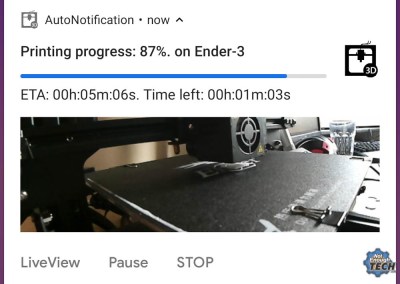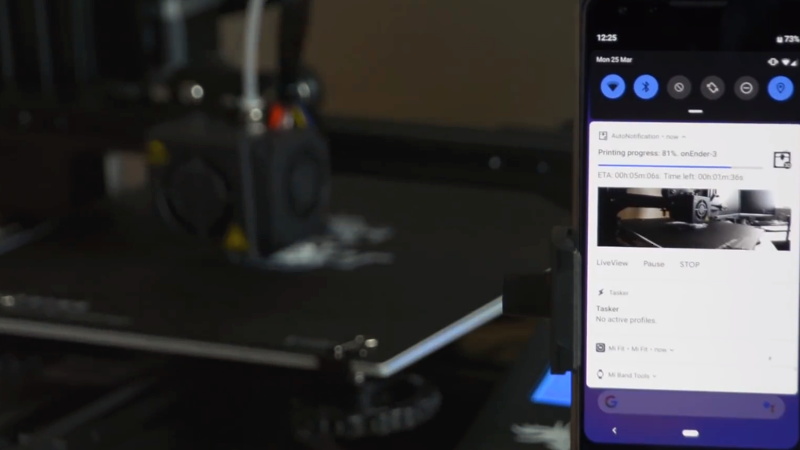Anyone with a desktop 3D printer knows that it can be a bit nerve-wracking to leave the machine alone for any extended period of time. Unfortunately, it’s often unavoidable given how long more complicated prints can take. With big prints easily stretching beyond the 20 hour mark, at some point you’re going to need to leave the house or go to sleep. We hope, anyway.
 In an effort to make his time away from his printer a bit less stressful, [Mat] from NotEnoughTECH has put together a comprehensive framework for monitoring his machine on the go. After looking at existing remote monitoring solutions, he found none gave him the level of information he was after. His system collects up an incredible number of data points about the printer’s current status and pushes it all to his Android phone as a rich notification. Best of all, he’s documented the entire system in exquisite detail for anyone else who might want to follow in his footsteps.
In an effort to make his time away from his printer a bit less stressful, [Mat] from NotEnoughTECH has put together a comprehensive framework for monitoring his machine on the go. After looking at existing remote monitoring solutions, he found none gave him the level of information he was after. His system collects up an incredible number of data points about the printer’s current status and pushes it all to his Android phone as a rich notification. Best of all, he’s documented the entire system in exquisite detail for anyone else who might want to follow in his footsteps.
There’s a considerable amount of hardware and software involved in this system, and getting it up and running won’t be quite as straightforward as using some of the turn-key solutions out there. Octoprint is responsible for controlling and monitoring the printer, and [Mat] is pulling data from its API using Node-RED. That data is formatted and ultimately delivered to his Android device as a notification with Tasker. On the hardware side he’s got a Sonoff POW R2 to not only turn the printer on and off but measure its energy consumption, a USB camera to provide a live view of the printer, and a couple of Raspberry Pis to run it all.
Even if you don’t have a 3D printer, or maybe just don’t leave the house to begin with, the video [Mat] has put together after the break that shows how all the elements of this system are pulled together in Node-RED is a fascinating look at the flow-based visual programming tool. Similarly, it’s a great demonstration on how Tasker can be used to add some very slick Android notifications for your project without having to commit to developing a native application for the platform.
If you like the idea of remotely monitoring your printer but aren’t ready to dive into the deep end like [Mat], there are easier options. With a Raspberry Pi running Octoprint added to your 3D printer and one of the existing mobile monitoring and control front-ends installed, you’ll be well on the way to tackling those big prints without having to pitch a tent in the lab.
















even better is to try the new Spaghetti Detective system
“Anyone with a desktop 3D printer knows that it can be a bit nerve-wracking to leave the machine alone for any extended period of time.”
And yet our regular printers don’t give us such feelings. That’s the direction development needs to go if the masses are going to accept these devices.
I’d say that printers in my life (the printer printers) always gave me a degree of trouble. There were never the case where I could just press the print button and have a page printed out over a network without some issues :D
PC LOAD LETTER
Have you found yourself doing many 20+ hour continuous print jobs on your $50 HP inkjet?
Your regular printers don’t have a 20+ hour print time. Also, when they screw up, they don’t tend to burn up… (https://hackaday.com/2018/03/18/3d-printer-halts-and-catches-fire-analysis-finds-a-surprising-culprit/)
I put off getting a 3D printer, until last month, was hoping they’d get more affordable, and less fiddly. Well, the price came down to reasonable, but gave up any hope, it would ever be hassle free. There are just too many variables, compared to paper print, to expect any different. Filament is variable, different materials, even different batches of the same brand can need a little adjustment. Every print job is a little different, and need a little tweaking. Only so much can be done with climate control, humidity can get real high here in Florida. I’m sure with more experience, I’ll get a feel for what settings I need to dial in for each type of print/material, but still need to make a few fine adjustments. Even if someone were to write software to analysis a model, and calculate the ideal settings for it, and the material, there would still need a little adjustment.
I’m a beginner, so a lot of what I say will be coming from a newbie perspective. It’s totally worth it. I was very impressed with what I can achieve with the cheap printer. True I won’t make high res figurines for tabletop games or production grade stuff, but I can make a box for any project I can think of or a custom mechanism to make something work. And for that – it’s worth trying.
I already experiment with the settings and make note of the changes. With that data I can improve for sure
It is possible, but it´s costly, i used Ultimaker, Anets, Prusas, GRR and many other printer. But the only one which offered true hassle free plug and play printing was Zortrax. It´s expansive and dongled but thats just the price for a hassle free experience i guess. We run five of these in our university operated by total noobs and they just run 24/7 with hardly any maintanance.
I user Repetier on a RaspberryPi to monitor mine and it has been such a good peace of mind.
I ALWAYS pitch a tent in the lab.